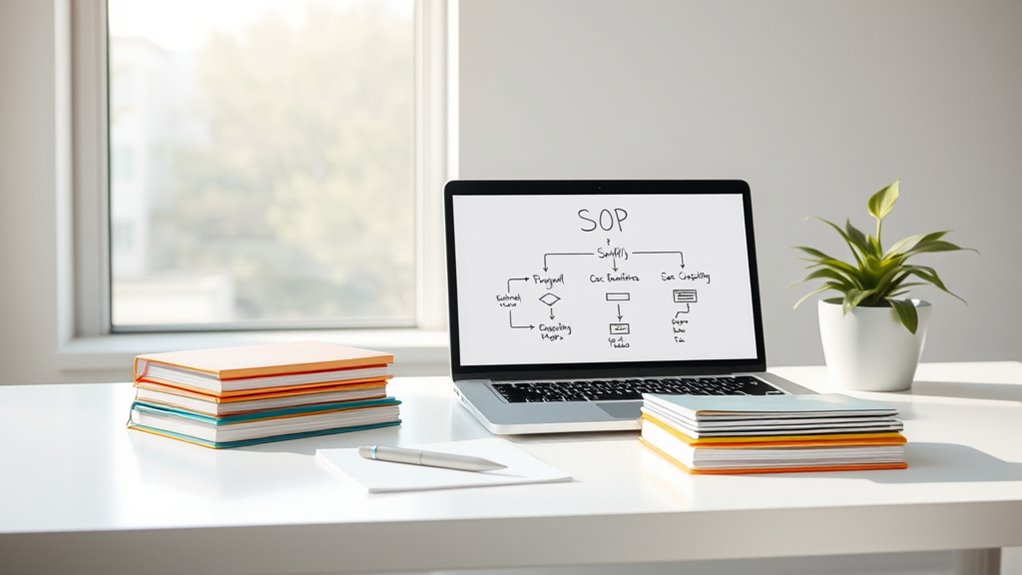To free your brain, create simple SOPs that clarify your tasks with clear, concise steps. Focus on key actions, use straightforward language, and add visual aids like checklists or diagrams. Keep instructions manageable so you can quickly follow them without confusion or overthinking. By doing this, you’ll minimize mental clutter, reduce errors, and boost your efficiency. Keep exploring to discover how these routines can help you work smarter and stay organized.
Key Takeaways
- Focus on core steps and clear language to make SOPs easy to understand and follow.
- Use visual aids like diagrams or checklists to simplify complex procedures.
- Keep instructions concise to prevent information overload and facilitate quick reference.
- Regularly update SOPs to improve clarity and adapt to process changes.
- Implement SOPs that enable automation and delegation, reducing mental load and decision fatigue.

Have you ever felt overwhelmed trying to follow complicated procedures? It’s a common experience, especially when processes are cluttered with unnecessary steps or confusing instructions. That’s where creating simple Standard Operating Procedures (SOPs) can make a huge difference. Clear, straightforward SOPs help streamline your workflow by clarifying each task’s purpose and steps, allowing you to focus on what truly matters. When your procedures are simplified, you can implement workflow automation more effectively. Automation tools thrive on well-defined, uncomplicated processes. By breaking down complex tasks into clear, manageable steps, you reduce errors and save time. This also makes it easier to set up automated routines that handle repetitive tasks, freeing up your mental bandwidth for more strategic activities.
Simplify procedures to boost workflow, reduce errors, and enable effective automation and delegation.
Task delegation becomes much smoother when your SOPs are simple. Instead of spending time explaining convoluted procedures, you can assign responsibilities confidently, knowing that your team understands exactly what needs to be done. Clear SOPs serve as a reliable reference point, ensuring everyone is on the same page and reducing the need for constant supervision or clarification. This not only speeds up task completion but also empowers your team to take ownership of their responsibilities. When procedures are easy to follow, new team members can get up to speed faster, and existing team members can refresh their knowledge quickly, especially during busy periods or when onboarding.
Creating simple SOPs involves stripping procedures down to their core essentials. Focus on the key steps, keep instructions concise, and avoid unnecessary jargon. Use clear language and visual aids like diagrams or checklists to make the process more intuitive. Remember, the goal is to make the SOP so straightforward that anyone could follow it with minimal guidance. Doing so reduces confusion and minimizes the risk of mistakes, which ultimately improves overall efficiency. Simplifying your SOPs also encourages continuous improvement. When processes are easy to understand, you’re more likely to identify areas that need refinement and update them promptly.
In the end, simple SOPs are about working smarter, not harder. They allow you to leverage workflow automation efficiently and delegate tasks confidently. When procedures are straightforward, you free your brain from the clutter of complex instructions, giving you more time to focus on strategic growth and innovation. By investing a little effort upfront to create clear, simple SOPs, you set the stage for smoother operations, happier team members, and a less stressful work environment.
Frequently Asked Questions
How Do I Choose Which Processes Need SOPS?
You should choose processes for SOPs through process mapping and task documentation. Start by identifying repetitive or high-impact tasks that, if standardized, save time and reduce errors. Focus on processes with frequent handoffs or complex steps, as these benefit most from clear instructions. Prioritize tasks that new team members need to learn quickly. This approach guarantees you’re creating SOPs where they’ll make the biggest difference in efficiency and consistency.
What Tools Can Help Me Create Effective SOPS?
Did you know that teams using digital tools for SOPs see a 30% boost in efficiency? To create effective SOPs, leverage documentation templates and digital tools like Notion, Trello, or Google Docs. These platforms simplify organizing, editing, and sharing procedures, ensuring consistency and quick updates. By using these tools, you make your SOPs clear, accessible, and easy to maintain, saving you time and reducing errors.
How Often Should SOPS Be Reviewed or Updated?
You should review your SOPs at least annually to guarantee they stay relevant. Set a regular revision frequency, like every six months, and update triggers such as process changes, feedback, or new regulations. By proactively scheduling reviews and monitoring for update triggers, you keep your SOPs current, effective, and aligned with your operations, which helps prevent issues and improves overall efficiency.
How Do I Train Staff on New SOPS?
Did you know that 70% of employees feel more engaged when properly trained? To train staff on new SOPs, use diverse training methods like hands-on practice, visual aids, and interactive sessions. Keep employees engaged by encouraging questions and feedback. Reinforce learning through follow-up sessions and easy-to-access reference materials. This approach guarantees better understanding, smoother implementation, and sustained compliance with your SOPs.
What Are Common Mistakes to Avoid When Writing SOPS?
You should avoid common mistakes like overlooking training gaps and lacking communication clarity. When writing SOPs, make sure they’re clear and straightforward so staff can easily follow them. Don’t assume everyone understands the process; instead, test for gaps in training and clarify any confusing steps. Failing to do so can lead to errors and inefficiency. Keep your SOPs simple, precise, and accessible to prevent misunderstandings and improve consistency.
Conclusion
By implementing simple SOPs, you can clear mental clutter and boost your productivity. Did you know that the average person spends over 4 hours daily on unnecessary tasks and distractions? Imagine reclaiming that time by streamlining your routines. With just a few straightforward steps, you’ll free your mind from overwhelm and focus on what truly matters. Start today, and watch how much clearer and more energized your brain becomes—you’re just a simple SOP away from a better day.








